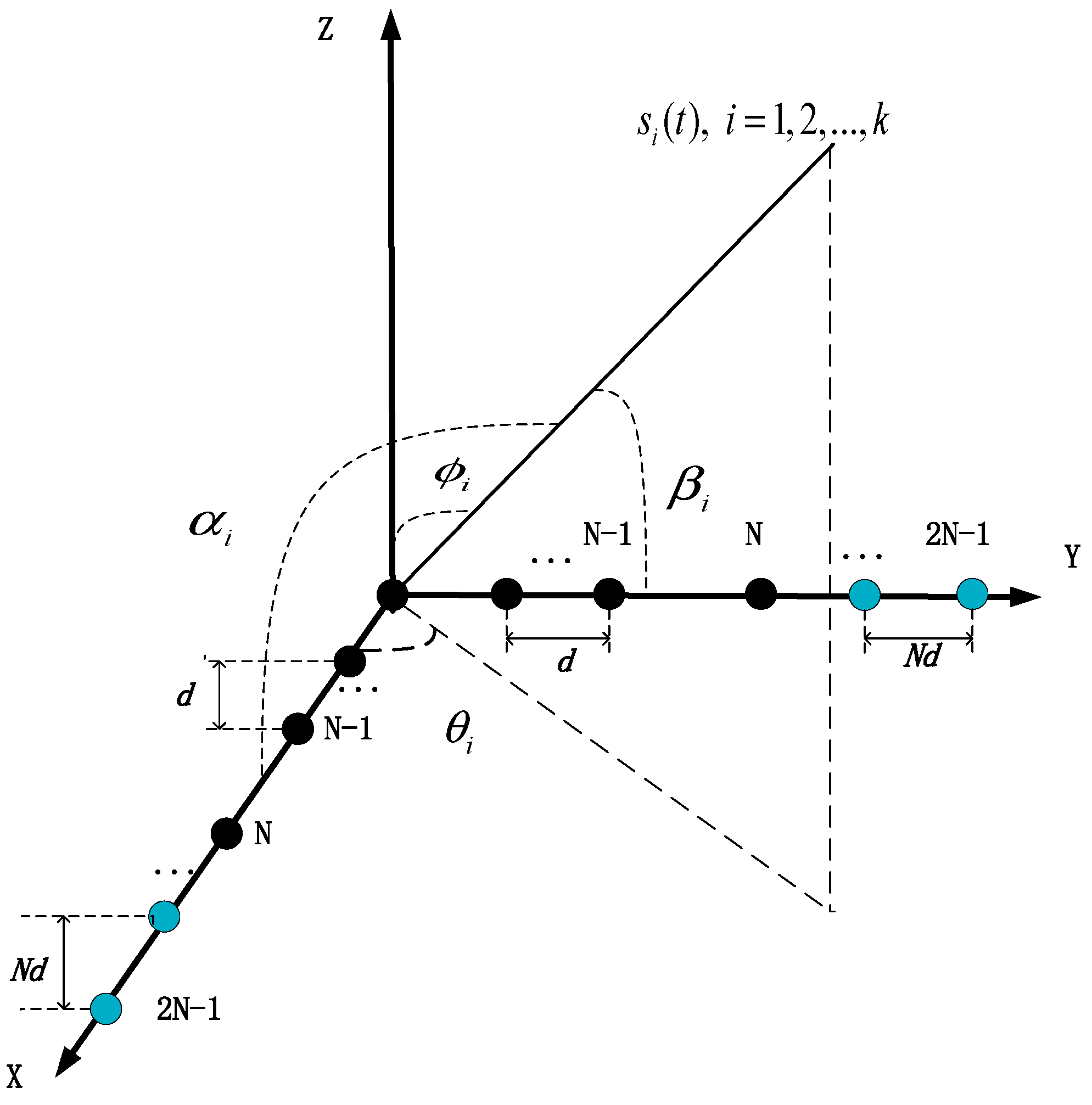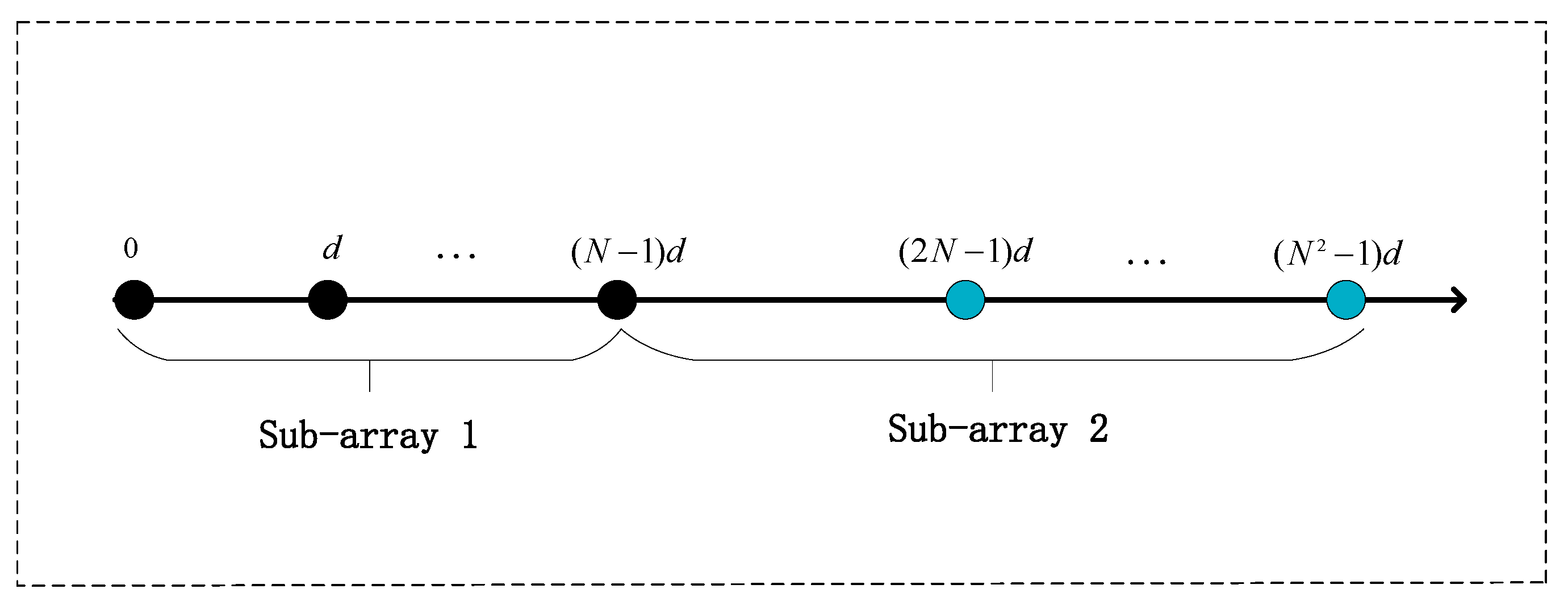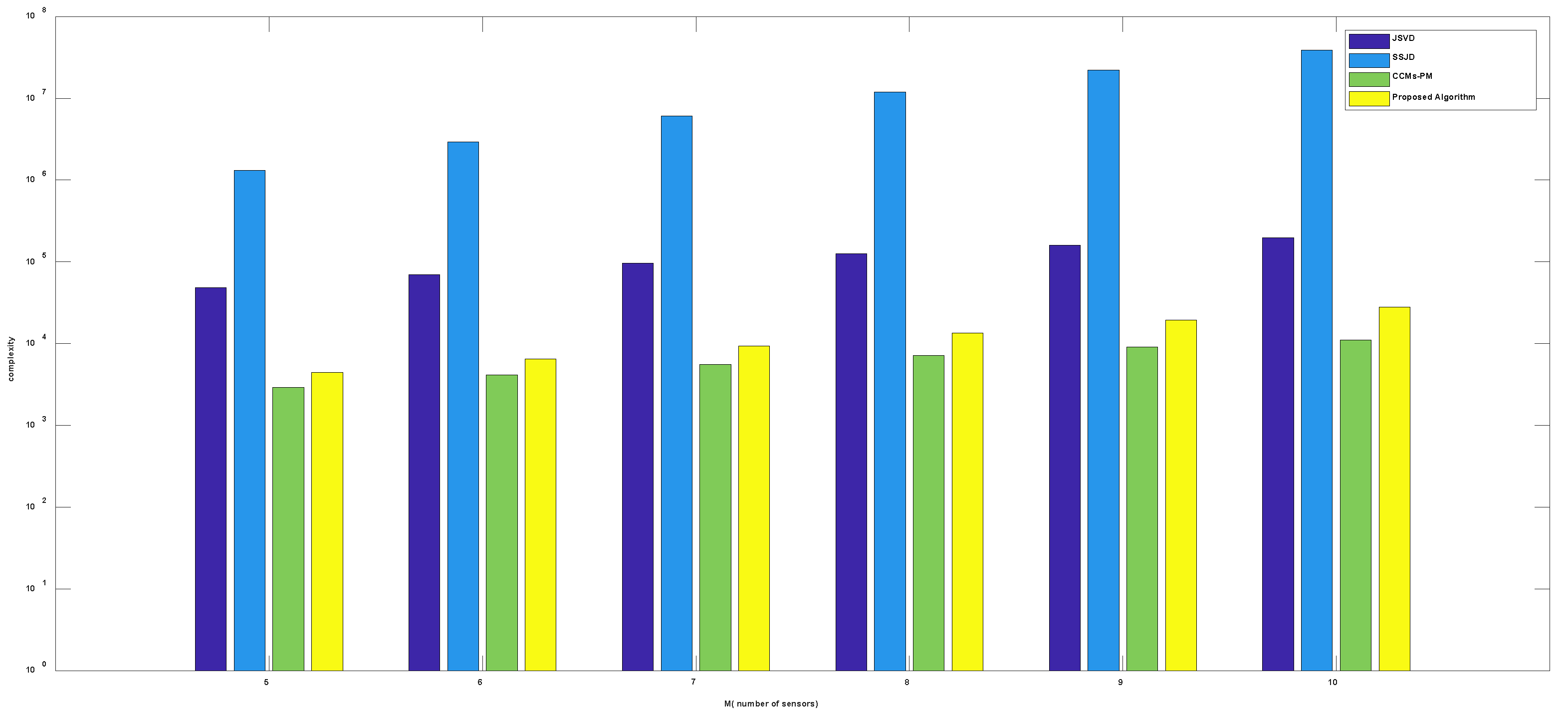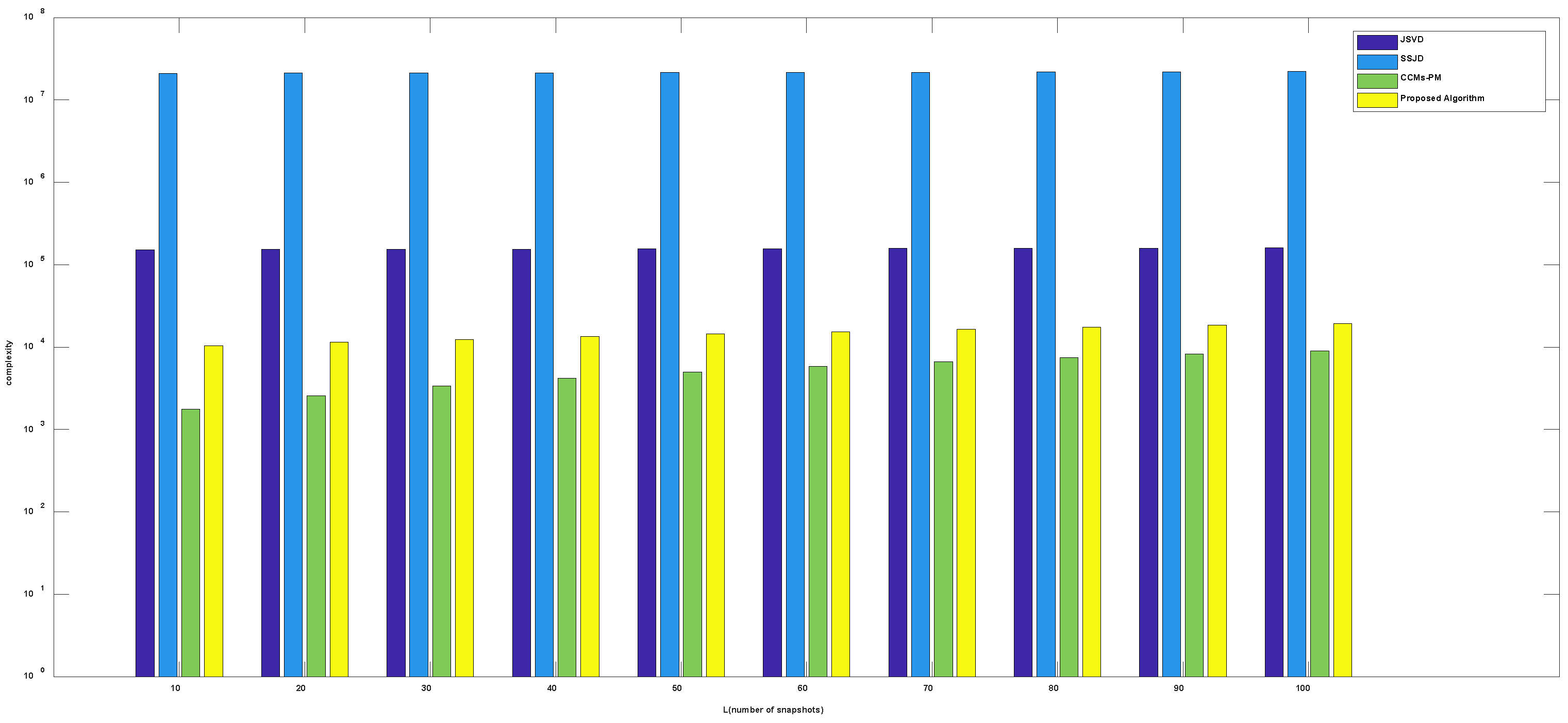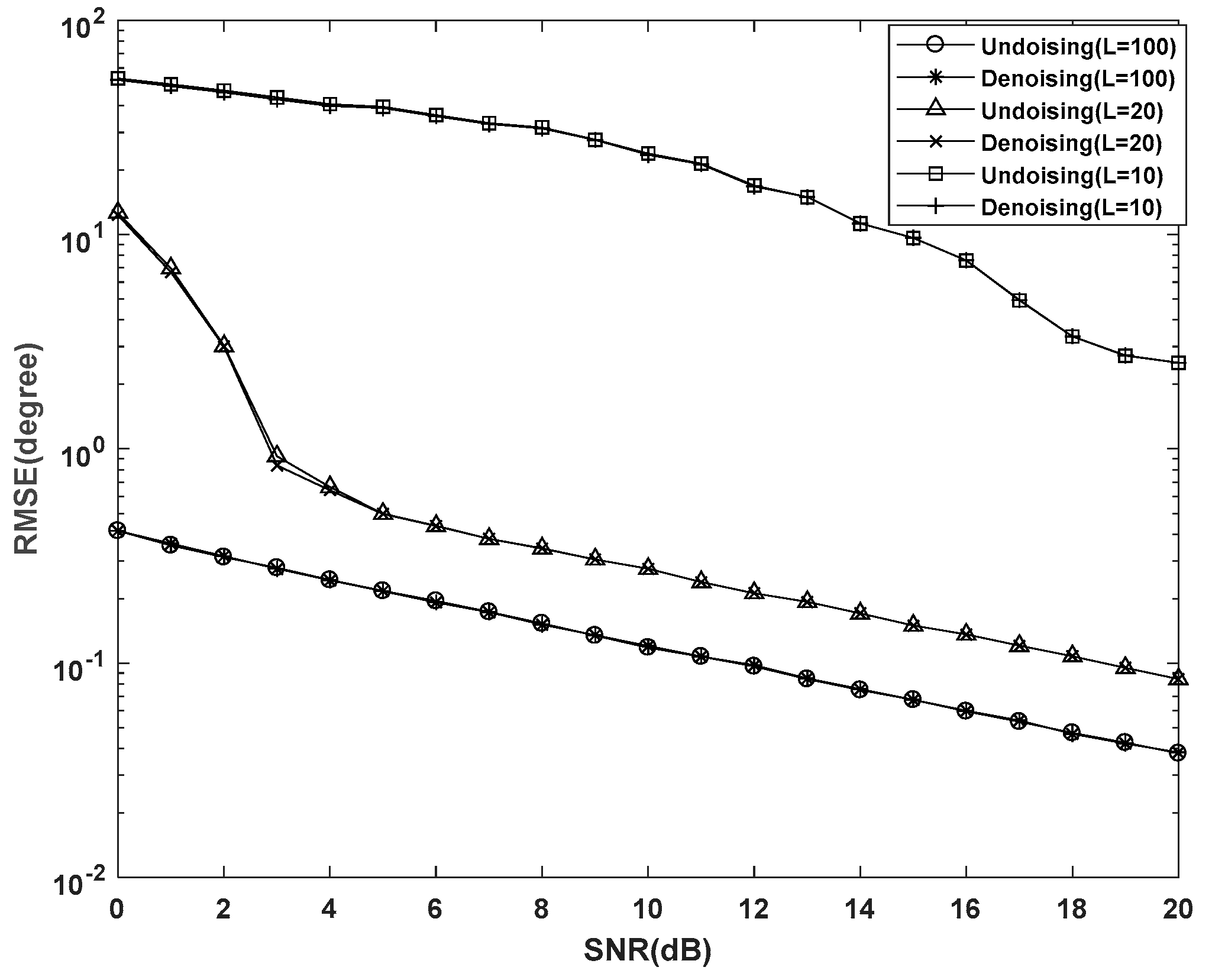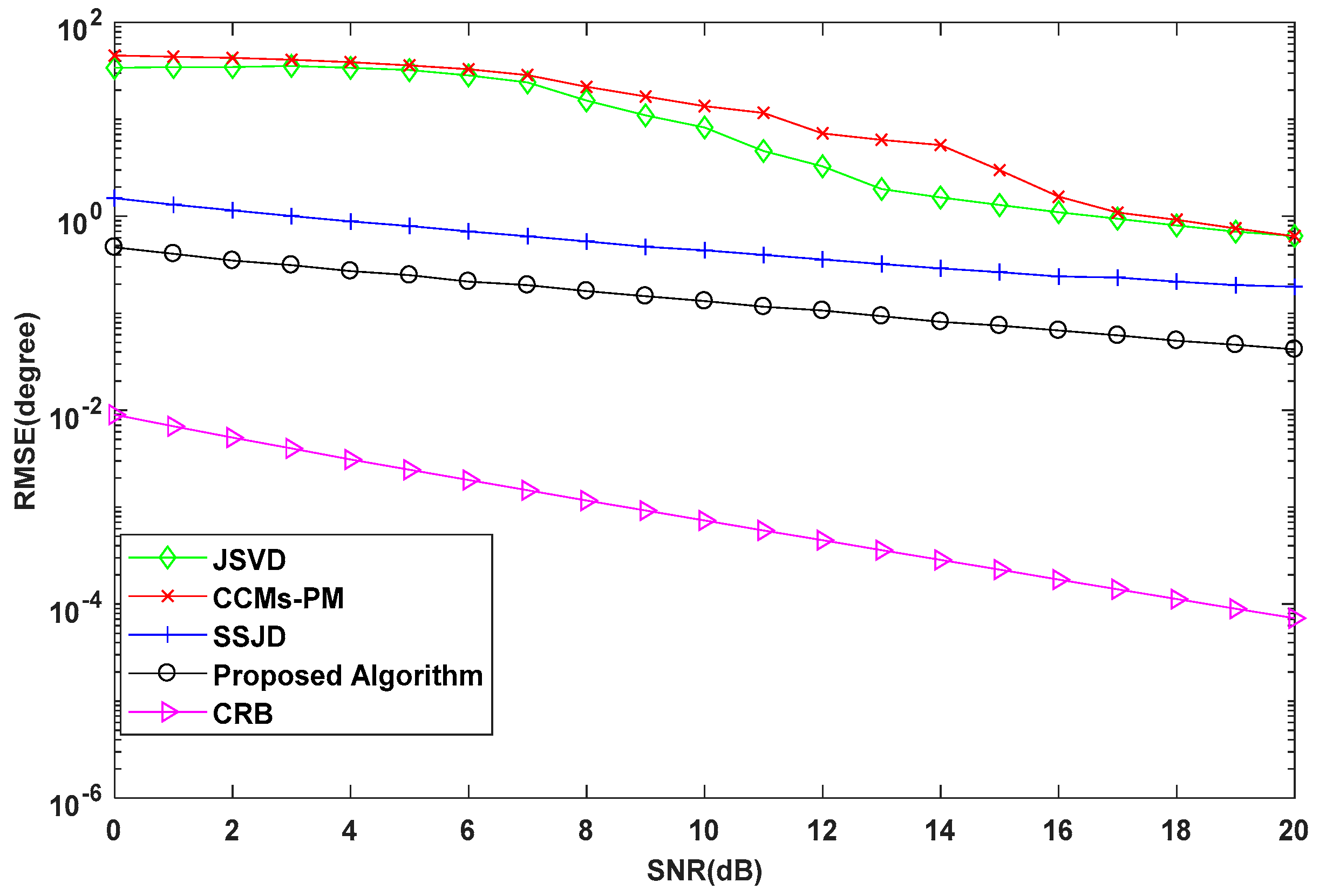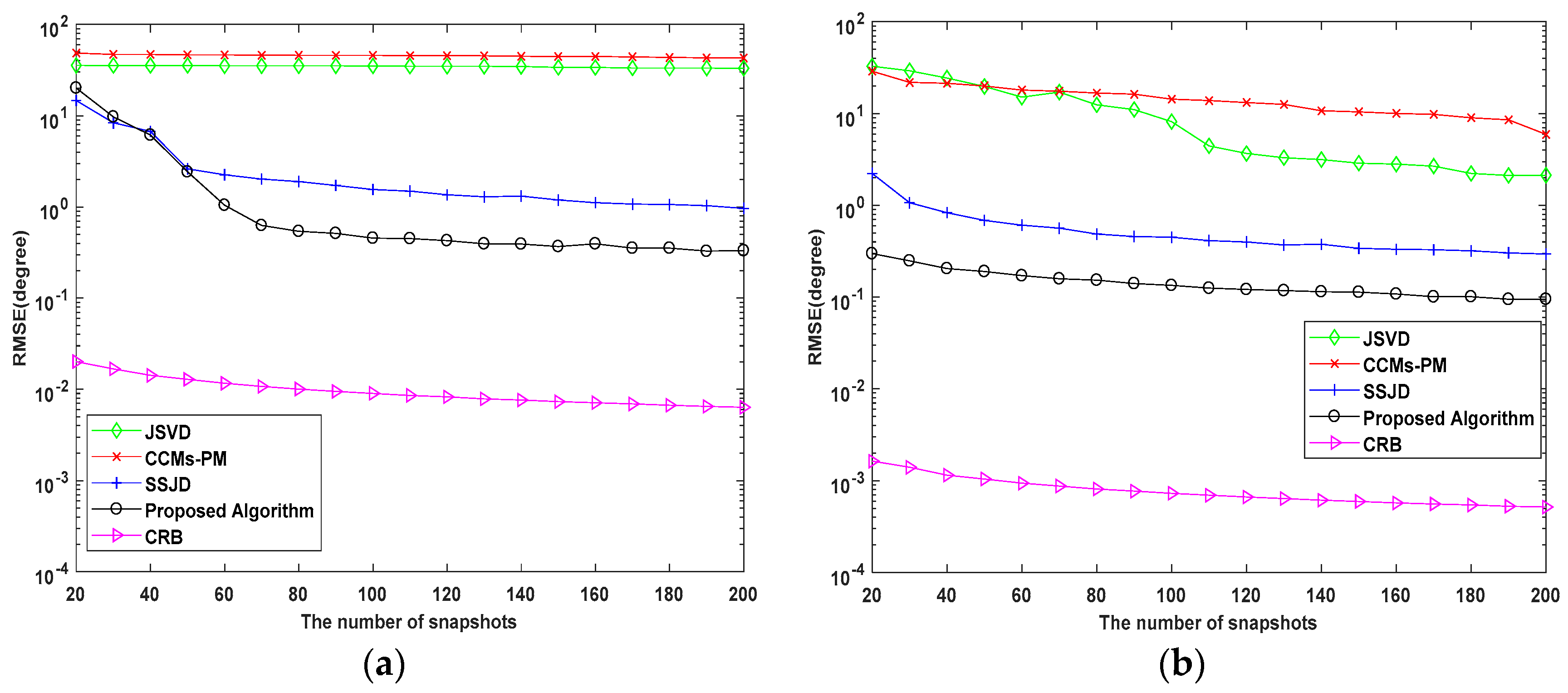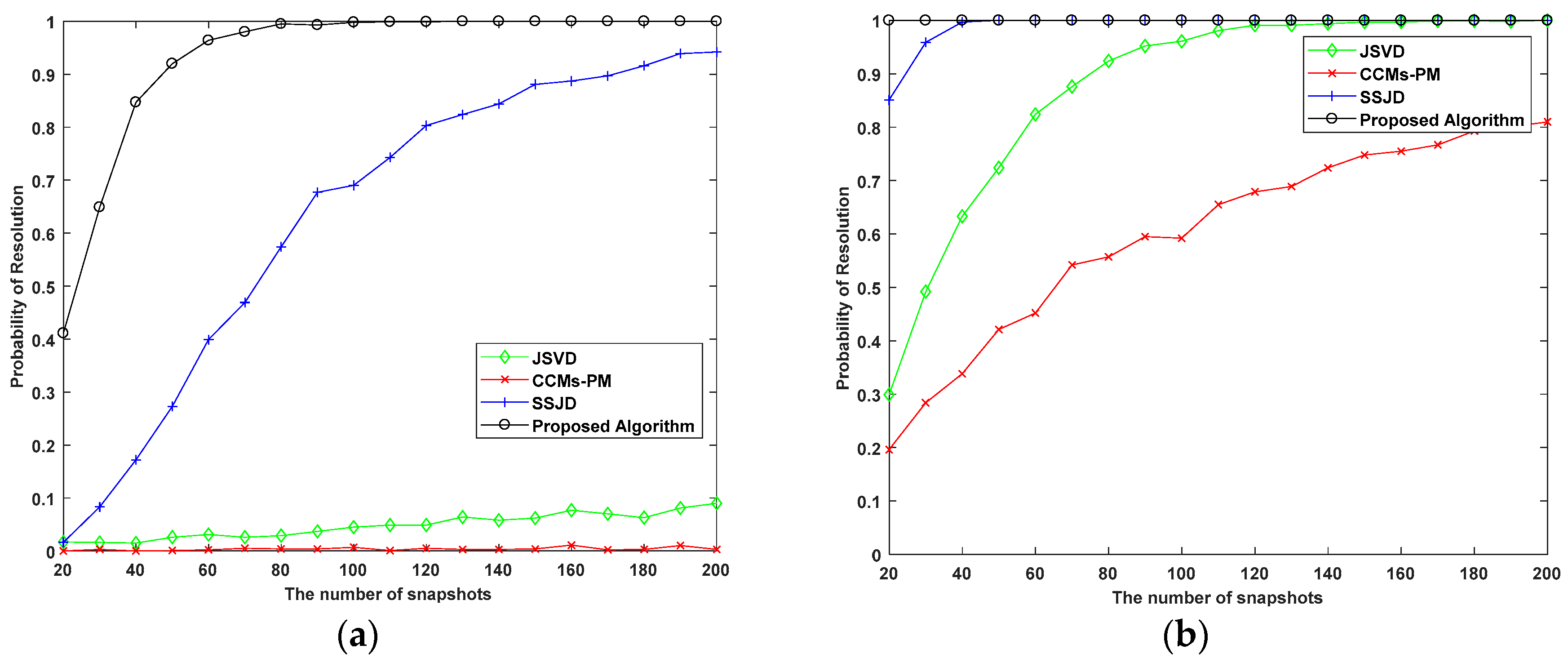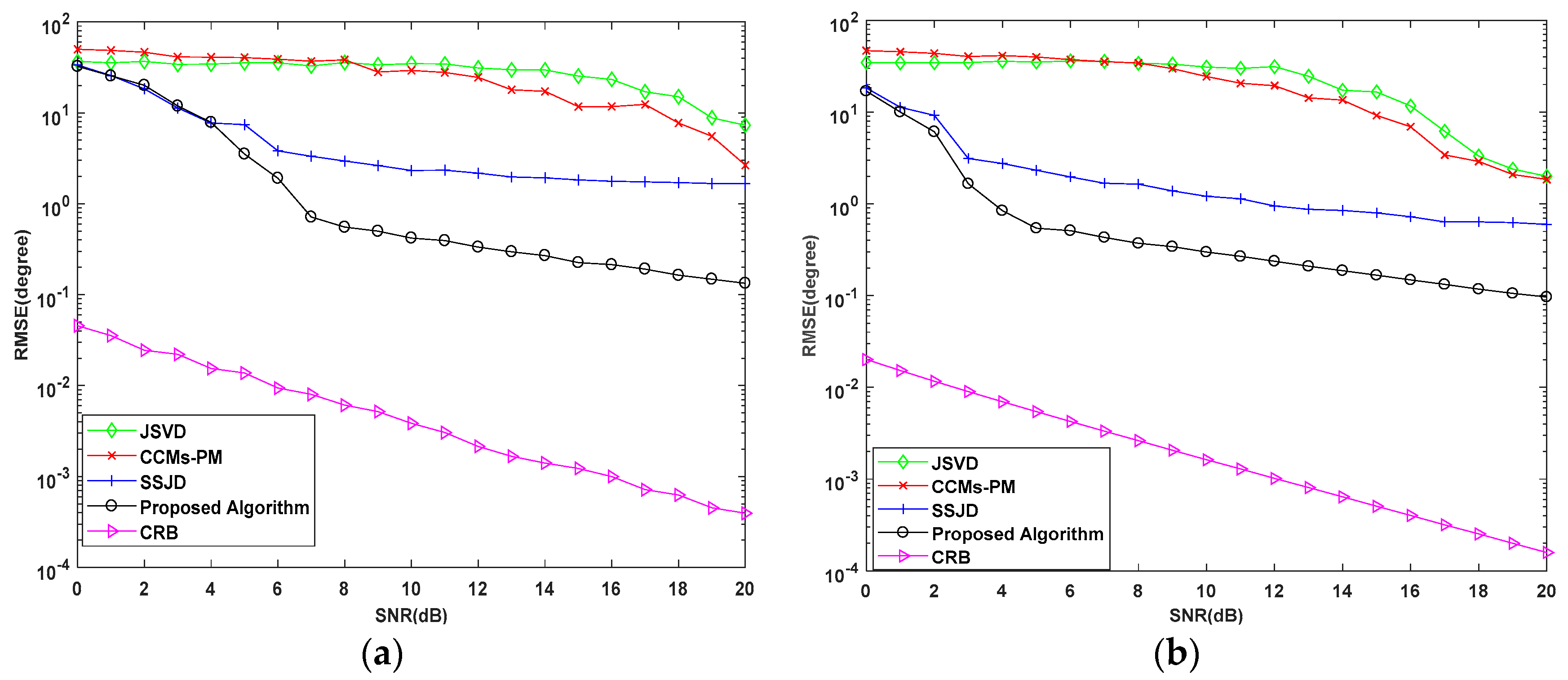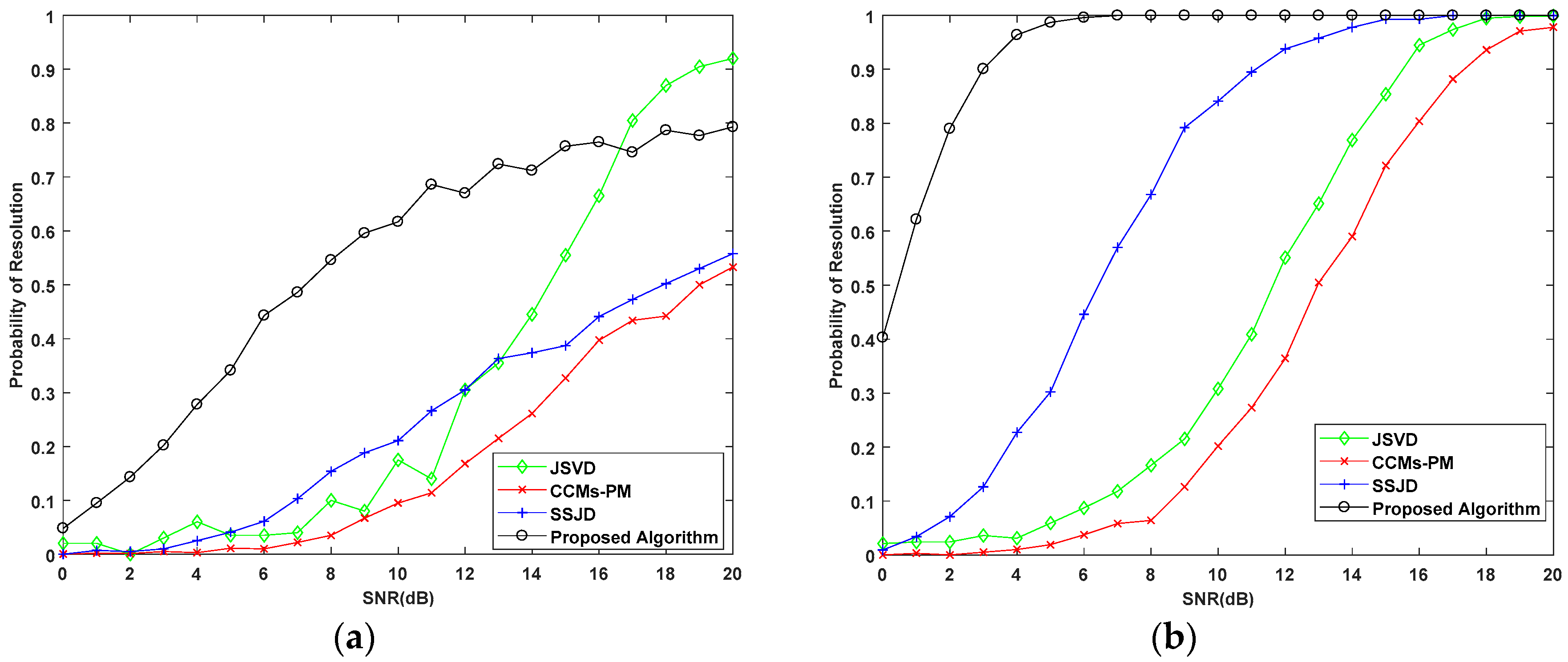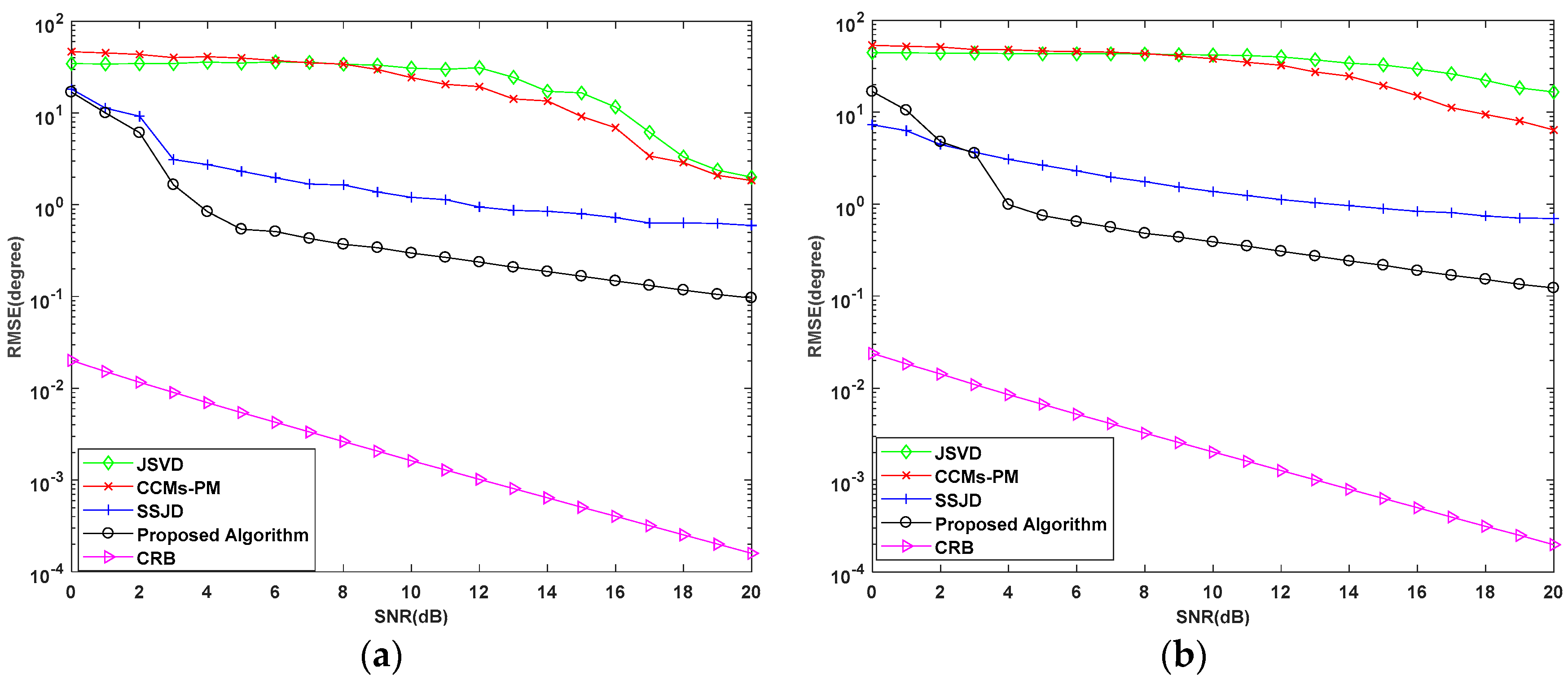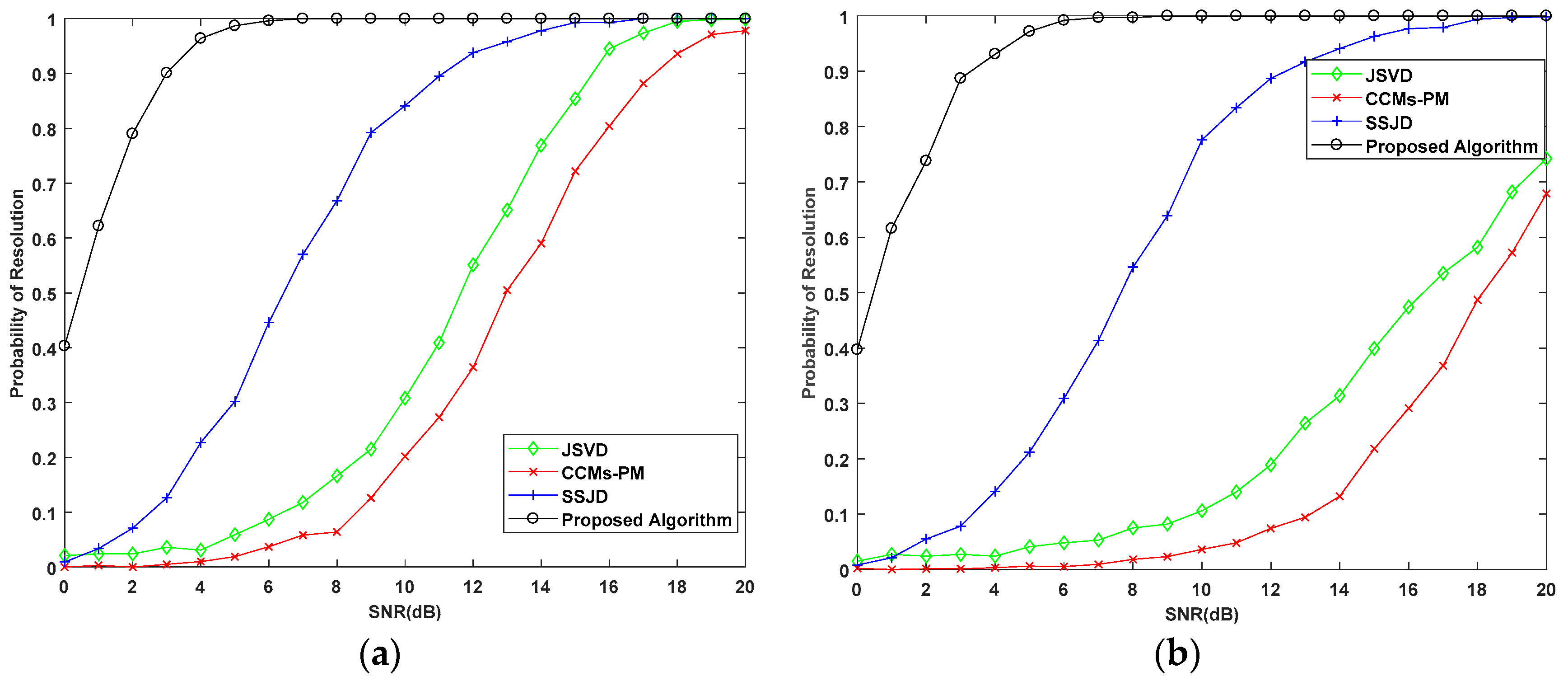1. Introduction
As an important field of array signal processing, direction of arrival (DOA) estimation has been applied in a wide range of applications such as wireless communications, sonar, radar, and acoustic localization [
1,
2,
3]. Furthermore, signal sources location and identification are essential for monitoring the electromagnetic environment, and several different technologies based on parameter estimation have been applied to it [
4,
5,
6,
7]. The key problem of parameter estimation is estimating the azimuth and elevation angles. To obtain these angles, several DOA estimation methods have been proposed, such as multiple signal classification (MUSIC) [
8], Time-Reversal MUSIC (TR-MUSIC) [
9,
10,
11], Root-MUSIC [
12], estimation of signal parameters via rotational invariance technique (ESPRIT) [
13], and so on. Compared with 1-D DOA estimation, the study of 2-D DOA estimation, which can obtain the azimuth and elevation angles simultaneously, has attracted much attention. Numerous high-resolution 2-D DOA estimation methods with different structured arrays have been proposed, including the two-parallel arrays [
14,
15], circular arrays [
16,
17], uniform rectangular arrays [
18,
19,
20], and L-shaped arrays [
21,
22,
23,
24,
25,
26,
27,
28,
29,
30]. Due to the wider coverage area and lower Cram’er-Rao boundary (CRB) [
31], great efforts have been focused on 2-D DOA estimation for L-shaped arrays.
Due to the geometric configuration of L-shaped arrays, the elevation and azimuth angles can be estimated independently from each linear arrays. As the classical subspace method, MUSIC can be directly employed to the received data matrix of L-shaped arrays [
21], but 2-D pseudo-spectrum searching of MUSIC requires a large number of calculations. An algorithm based on the propagator method (PM) has been proposed to estimate the angles with two L-shaped arrays [
22], but the algorithm needs an extra pair-matching method. Consequently, a pair-matching algorithm has been proposed by utilizing the diagonal factors of the cross-correlation matrix (CCM) [
23]. To avoid pair-matching of azimuth and elevation angles, an estimation algorithm based on joint singular value decomposition (JSVD) has been proposed to obtain the auto-matched azimuth and elevation angles [
24]. However, the beamforming-like operation of the algorithm requires heavy calculations. By employing the shift-invariance property of the CCM, an algorithm based on ESPRIT has been proposed [
25], which performs eigenvalue decomposition (EVD) on improved CCMs to estimate the angles. Considering the properties of several CCMs with the same signal subspace, a subspace-based algorithm without singular value decomposition (SVD) or EVD has been proposed to obtain the azimuth and elevation angles [
26]. Although this algorithm can acquire the signal subspace without SVD or EVD, the algorithm needs to minimize a cost function, which requires heavy calculations. In order to expand the array aperture and snapshots, the researchers have proposed an estimation algorithm based on the conjugate symmetry property of the uniform array’s manifold matrix [
27]. However, the expanded snapshots only benefit the azimuth or elevation angles. Nie, X. [
28] has presented a 2-D DOA estimation algorithm for closely spaced sources, which performs SVD on two matrices constructed by CCMs to estimate the azimuth and elevation angles. Pair-matching is achieved by using the conjugate property of the non-zero eigenvalues of two matrices. To reduce the complexity of 2-D DOA estimation, a novel auto-matched PM for L-shaped array has been presented [
29]. Unfortunately, the signal subspace is obtained directly from CCM, and thus the performance of the method is affected by the residual correlations of noise vectors. Liang, J. [
30] has proposed a joint 2-D DOA estimation algorithm, which constructs a new angle with the elevation and azimuth angle and divides the arrays into two sub-arrays. The ESPRIT algorithm is then performed to obtain the azimuth and elevation angles without additional pair-matching.
All of the algorithms mentioned above are applied to the L-shaped uniform arrays, which confine the aperture and the maximum number of incident signal sources to be estimated. In contrast to the uniform arrays, sparse arrays with more degrees of freedom (DOF) and larger apertures have aroused the interest of scholars and researchers, such as minimum redundancy arrays [
32], co-prime arrays [
33], and nested arrays [
34]. Co-prime arrays have been proposed for increasing the DOFs and improving the estimation resolution. However, the co-arrays of co-prime arrays are usually not a filled uniform, which may lead to phase ambiguity. To make the utmost of the co-arrays, an off-grid method has been proposed [
35], which interpolates the additional sensors to the generated co-arrays to convert the non-uniform arrays into uniform linear arrays (ULA). Zhou, C.W. [
36] has proposed an estimation method based on virtual arrays interpolation to reconstruct the covariance matrix of co-arrays, which can utilize all the derived co-arrays. Compared with other sparse arrays, nested arrays with
N physical sensors can generate
DOF with a closed-form expression. Therefore, several algorithms based on sparse L-shaped arrays have been proposed for 2-D DOA estimation. Jian-F. G. [
37] has proposed a joint 2-D DOA estimation algorithm for the L-shaped sparse arrays, that are composed of one uniform linear arrays and one sparse linear arrays (SLA). In order to obtain the auto-matching angles, the elevation angle is estimated first, and the azimuth angle is estimated using the estimated elevation angle. The resolution of the elevation angle estimated by the ULA is not as high as the azimuth angle estimated by the SLA. To make use of the advantages of nested arrays, an interlaced double precision 2-D DOA estimation algorithm using L-shaped nested arrays has been presented [
38]. However, the azimuth or elevation angle is achieved based on solving a least-squares problem with another estimated angle. Influenced by noise perturbations, high-precision estimation can only be obtained for either the azimuth or elevation angle. By utilizing the spatial-temporal property of signals, Dong, Y.Y. [
39] has proposed an algorithm for L-shaped nested arrays, which constructs several CCMs with different time lags and performs a signal subspace joint diagonalization technique (SSJD) to estimate the azimuth and elevation angles simultaneously. However, the number of valid snapshots is reduced by dividing output dates into several frames, and the SSJD technique requires a loop iterative operation which requires heavy calculations.
In this paper, we propose an improved algorithm for L-shaped nested arrays in order to estimate the azimuth and elevation angles with a small number of snapshots. The array configuration is composed of two orthogonal nested arrays in the X-Y plane. Rather than using the auto-correlation matrix (ACM) of nested arrays, we calculate the CCM using the output of different sub-arrays, which removes the noise vector. Considering the perturbation of the sample cross-correlation matrix under a small number of snapshots, we reconstruct the CCM by using SVD. The sub-matrices of the reconstructed CCM are used to generate two large consecutive virtual arrays without an overlap element or residual noise. Since the equivalent received signals of virtual arrays behave like coherent sources, the output of the virtual arrays and their conjugate vectors are used to construct the full rank Toeplitz matrix as the equivalent covariance matrix. This process overcomes the rank deficiency of the virtual arrays. To reduce the computational complexity of the algorithm, a unitary ESPRIT method is performed on the equivalent covariance matrix to estimate the azimuth and elevation angles, separately. Since the azimuth and elevation angles are obtained, we achieve the pair-matched angles by deriving the equivalent source vector of the virtual arrays with the estimated angles. Our procedure can also estimate the power of the incident signals. Detailed analysis and numerical simulation are provided to demonstrate the lower complexity and better performance of the proposed algorithm.
The rest of the paper is organized as follows. The array configuration and signal model are illustrated in
Section 2. A description of the proposed algorithm is introduced in
Section 3. The simulation results and analysis are shown in
Section 4, and the conclusion is presented in
Section 5.
The following notations will be used throughout the paper. Vectors and matrices are denoted by using lower-case and capital bold letters, respectively. The superscripts , , , and represent the conjugate, transpose, pseudo-inverse, and conjugate transpose operations, respectively. The symbol denotes the Khatri-Rao product between two matrices, and denotes the column vectorization operator, which turns a matrix into a column vector. The symbol represents the expectation operator. Finally, the notation denotes an exchange matrix with ones on its anti-diagonal and zeros elsewhere.
2. Array Configuration and Signal Model
The array geometric configuration is illustrated in
Figure 1; the L-shaped nested arrays are composed of two orthogonal nested arrays in the X-Y plane. Each nested arrays consists of two ULAs, where the inner ULA contains
sensors with inter-sensor spacing
and the outer ULA contains
sensors with inter-sensor spacing
, where
, and
is the wavelength of the incident signal. The sensor at the origin is seen as the reference sensor. All sensors are assumed to be identical, omnidirectional, and isotropic. Suppose that there are
far-field, uncorrelated, narrowband signals
, impinging from distinct directions. Note that there are two ways to define the incident angles of sources. The first way is in terms of the azimuth angle
, measured between the projection of
i-th incident signal in the X-Y plane and the X-axis, and the elevation angle
, measured between the
i-th incident signal and the Z-axis. The second set of angles included the angle
, which is measured between the
i-th incident signal and the X-axis, and the angle
, which is measured between the
i-th incident signal and the Y-axis. It is easy to verify that a relationship between the angles
and the angles
exists, as shown in:
The array output vectors at the sub-array along the X-axis and Y-axis are written in matrix form as follows:
where
,
are the
array manifold matrices of the X-axis and Y-axis, respectively, and the
i-th manifold vectors
and
are expressed as follows:
Additionally,
is the source signal vector,
and
are the additive noise vectors. In this paper, we suppose the incident signals with variances
are uncorrelated to each other, the additive noise is temporally and spatially complex white Gaussian noise with zero mean and variance
, which are statistically independent of the signals. The number of incident signals
has already been estimated by a number detection technique. These properties of the source signal vector and additive noise vectors can be written as:
where
and
indicate identity and null matrices, respectively.
3. The Proposed Method
3.1. Constructing the Cross-Correlation Matrix for a Small Number of Snapshots
We divide the nested arrays of the X-axis into two subarrays, as shown in
Figure 2. Since the arrays along the X-axis and Y-axis have similar structures, the sub-array division of Y-axis is analogously divided. The nested array along the X-axis is composed of 2
N−1 sensors, there are
N sensors in each sub-array, where the
N-th sensor is shared by both sub-arrays. Sub-array 1 is a uniform linear array containing
N sensors with spacing
, and sub-array 2 is a uniform linear arrays contained
N sensors with spacing
. The output vectors of sub-array 1 and sub-array 2 are given respectively by:
where
and
are the noise vectors of sub-array 1 and sub-array 2, respectively. In addition,
and
denote the manifold matrices of sub-array 1 and sub-array 2, respectively, where the
i-th column of these two manifold matrices are written as
Similarly, sub-array 3 along the Y-axis is a uniform linear array containing
N sensors with spacing
, and the sub-array 4 along the Y-axis is a uniform linear array containing
N sensors with spacing
, the output vector can be written as:
where
and
are the noise vectors of sub-arrays 3 and 4, respectively,
and
are the manifold matrices of sub-array 3 and 4, respectively, where the
i-th column of these two manifold matrices are written as:
By constructing the vectors with the outputs of the subarrays
and
, the CCM of the two vectors can be computed as:
According to the Equation (17), the submatrices of
can be expressed as:
where
, and
denotes the power of the
k-th signal source. Since the noise vectors of different sensors are spatially independent and uncorrelated, the elements of
are all zeros except for the element
. Considering that the matrix
is an extremely sparse matrix, with only one non-zero element, it has little effect on the cross variance matrix
, so we omit it here and in the coming analysis. The noise term
is omitted only for simplifying analysis. The effect of omitting noise term
on DOA estimation is examined in
Section 4. From Equations (18)–(21), the noise vector is removed by the cross-correlation operation.
We perform SVD on
, which can be expressed as:
According to the second-order statistical properties of array signals, and are rectangular diagonal matrices with the K large singular values and other small singular values on the diagonal; , , , and are unitary matrices whose columns are left-singular vectors and right-singular vectors corresponding to and . Considering the noise vectors are removed by the cross-correlation operation, should be the null matrix.
In practice, the CCM
is replaced by the sample CCM
. Assuming that
L snapshots are available, the sample CCM matrix
is:
Performing SVD on
can be thus expressed as:
For small numbers of samples, the additive noise vectors does not satisfy the statistical assumptions in Equation (8). As mentioned in Ref. [
40], if the number of samples is high, the singular values of the sample CCM will converge to the singular values of the CCM. On the contrary, the eigenvalues of the sample CCM will diverge in a large cluster. Therefore,
may not equal the null matrix for small numbers of samples.
To reduce the perturbation of additive noise in the sample CCM
with small numbers of samples, we make the matrix
to reconstruct the modified CCM
:
Comparing Equation (25) with Equation (24), it can be concluded that using the matrix instead of means that the sub-matrix is omitted.
3.2. Virtual Arrays Generation Based on the CCM for Nested Arrays
In this section, we first review the virtual arrays of the original nested arrays. As mentioned in Ref. [
34], the nested arrays were proposed to obtain
DOF from
sensors by vectorizing the ACM of the received signals as follows:
where
is the ACM of the received signals,
is the output of the physical array,
denotes the equivalent signal vector,
is the noise vector of the virtual arrays,
is a column vector of all zeros except a 1 at the
i-th position, and
can be seen as the manifold matrix of the virtual arrays.
The locations of virtual arrays can be expressed by the set
, where
denote the position vector of the
i-th sensor. According to the analysis in Ref. [
33], the set
D contains the self-differences set
and the cross-differences set
, defined as:
where
denotes the position vector of first level subarray with spacing
,
denotes the position vector of second level sub-array with spacing
,
is the number of sensors in the first level subarray, and
is the number of sensors in the second level subarray. From Equations (27) and (28), the cross-differences set
contributes the majority of sensor locations, the self-differences set
contributes the remaining sensor locations, which contain some overlapping ones. In addition, the output of the virtual arrays contains noise
, which need an extra operation to remove. In order to obtain the virtual arrays without the overlapping element and noise, we propose an improved L-shaped nested arrays based on CCM, in order to take full advantage of the cross-differences property.
We divide the modified CCM
into four sub-matrices as shown in Equation (17), and then reverse the matrices
and
according to the columns, which can be expressed as:
We utilize the matrices
and
to calculate the following vectors:
where
,
, and the equivalent signal vector is expressed by
. Additionally,
can be seen as the output of the virtual arrays along the X-axis, whose manifold is given by
;
can be seen as the output of the virtual arrays along the Y-axis, whose manifold is given by
; and the
i-th column of matrix
and
are respectively written as:
Defining
and
as the outputs of the virtual arrays, where
and
denote the output of
i-th virtual array along the X-axis and Y-axis, respectively. The conjugate vectors of
and
are expressed as follows:
where
and
denote the conjugate vector of the
i-th virtual array’s output along the X-axis and Y-axis,
,
, and
. The
i-th column of the matrices of
and
are written as:
According to the Equations (35) and (36), and can be seen as the outputs of virtual arrays whose manifold are given by and , respectively. Defining , which behaves like the output of a uniform linear array along the X-axis containing elements with spacing , and , which behaves like the output of a uniform linear array along the Y-axis containing elements with spacing . Thus, we obtain the virtual arrays of elements in the X-Y plane using only physical sensors, which dramatically increases the DOF.
3.3. Improved Unitary ESPRIT Algorithm for Received Signals of Virtual Arrays
According to the outputs of the virtual arrays in Equations (31), (32), (35), and (36), the equivalent signal vector behaves like coherent signal sources that lead to a rank deficiency of the covariance matrix. Hence, the conventional high-resolution DOA estimation algorithm such as MUSIC or ESPRIT can’t be directly used for the virtual arrays. In this subsection, the equivalent covariance matrix is constructed to estimate the DOA of the virtual arrays.
Since the covariance matrix is a Toeplitz matrix, we can use
to construct the equivalent covariance matrix
:
From Equation (33),
is Vandermonde matrix that satisfies the property of rotational invariance. After performing the EVD of the matrix
, the rotational invariance property can be expressed as:
where
is the matrix composed of eigenvector corresponding to the
K largest eigenvalues,
,
, and
.
The ESPRIT algorithm needs to perform SVD or EVD on the complex covariance matrix which means leads to a high computational burden. To reduce the computational complexity of the algorithm, the unitary transformation is used to transform the complex covariance matrix into a real-valued matrix [
41]. We construct the Centro-Hermitian matrix
:
Additionally, we define the unitary matrix:
We use the unitary matrix
to transform the complex matrix
into real matrix
via:
After the unitary transformation, the complex rotational invariance property of Equation (40) becomes the real-valued rotation; invariance property as follows:
where
,
, and
.
From the Equation (44), the
can be obtained by the least square method:
By performing EVD on
, the angle
can be obtained from the
i-th eigenvalue
of
as follow:
Similarly, we use
and
to construct the equivalent covariance matrix
:
We then use the unitary matrix
to transform
into real matrix
as follow:
After the unitary transformation, the real-valued rotation invariant property is written as:
where
.
Then
can be obtained by the least square method. After performing EVD on
, the angle
can be obtained from the
i-th eigenvalue
of the matrix
as follows:
3.4. Pair Matching
Since the angles
and
are separately obtained by 1-D DOA estimation. This may lead to a mismatch between angle
and angle
with more than one incident signal. From Equations (31) and (32), the equivalent signal vector
of different virtual arrays is the same vector. The manifold matrix of virtual arrays
can be calculated with the estimated angle
. From Equation (31), the equivalent signal vector
can be derived by the least square method as follows:
Similarly, the manifold matirx
can be calculated with the estimated angle
. From Equation (32), the equivalent signal vector
can be derived via:
The elements of the equivalent signal vector
denote the powers of the incident signals. Due to the different power of incident signals, the pair matching problem can be done by sorting the elements of
and
:
where the
is the sorting matrix. Then the result of pair matching is the following:
According to Equations (53) and (55), the powers of incident signals have also been estimated.
3.5. Algorithm Implementation and Complexity Analysis
The proposed algorithm can be summarized as follows:
Step 1: Divide the nested arrays of into four subarrays. Construct the vectors and with the outputs of the subarrays. Then calculate the CCM .
Step 2: Perform SVD on the matrix to reconstruct the modified CCM via Equation (25).
Step 3: Divide the modified CCM into four sub-matrices as in Equation (17), then use the submatrices and to obtain the output of the virtual arrays via Equations (29)–(32).
Step 4: Construct the equivalent covariance matrices and with the output of the virtual arrays via Equations (39) and (47).
Step 5: Utilize the unitary matrix to transform the covariance matrix into a real-valued covariance matrix. Then conduct the ESPRIT algorithm on the real-valued covariance matrix to estimate the angles and .
Step 6: Derive the equivalent source signal vectors and with the estimated angles and via Equations (52) and (54), respectively. Derive the sorting matrix , and pair the angles and by using the sorting matrix .
As for the complexity of algorithm, the main computation of algorithm contains the reconstructing CCM, SVD operation, pseudo-inverse operation and the least square method. Considering that the virtual arrays extend the dimension of the equivalent covariance matrix, which need a lot of calculations, the unitary transformation is performed on equivalent covariance matrix to reduce the computational complexity of the proposed algorithm. The main computational complexity of our proposed algorithm is
, where
denotes the number of sensors,
denotes the number of snapshots,
denotes the number of incident signals. The algorithm of joint singular value decomposition (JSVD) [
24] involves a beamforming-like spectral search. By defining the search step of
degree, the computational complexity of JSVD is about
. On the other hand, the method of cross-correlation matrices propagator method (CCMs-PM) [
29], which obtain the DOAs without EVD or SVD, cost approximately
. The methods of JSVD and CCMs-PM are applied on L-shaped uniform arrays. The method of signal subspace joint diagonalization (SSJD) [
39], performed on nested arrays, requires a complexity of
, where the
N is frame number of the method. For the sake of clarity, the main complexity of the proposed algorithm, the JSVD algorithm, the SSJD algorithm, and the CCMs-PM algorithm are listed in
Table 1.
Figure 3 shows the complexity comparison of algorithms versus the number of sensors, where the number of snapshots
L is 100, the number of incident signals
k is 3.
Figure 4 shows the complexity comparison of algorithms versus the number of snapshots, where the number of sensors
M is 9, the number of incident signals
k is 3. From
Figure 3 and
Figure 4, the complexity of the proposed algorithm is much lower than the JSVD and SSJD algorithms. The low computational complexity is obtained from the unitary transformation of the complex matrix into a real-valued matrix. Although the complexity of the proposed algorithm is a bit higher than the CCMs-PM, the computational complexity of the proposed algorithm is basically on the same order as the complexity of CCMs-PM.
4. Simulation Results and Performance Analysis
In this section, several simulation experiments are conducted to verify the performance of the proposed algorithm. Consider L-shaped nested arrays consisting of two orthogonal nested arrays, where each nested array contains nine sensors, of which the inner ULA contains five sensors with an inter-sensor spacing of and the outer ULA contains four sensors with an inter-sensor spacing , where is the wavelength of the incident waves. Consider that three signals are impinging from the locations , , and . The power of signals are set as , , and . The input signal-to-noise-ratio (SNR) is defined as , where and denote the power of signal and noise, respectively.
Two criteria for assessing the performance of the DOA estimation algorithm are the probability of resolution and the root mean square error (RMSE). The probability of resolution is defined as the probability that the angle difference between the estimated angle and the real angle is less than half of the beam width among several Monte-Carlo experiments, which can be expressed as follows:
where
denotes the beam width.
The definition of RMSE is as follows:
where
and
are the estimated angles of
j-th incident signal for
i-th Monte-Carlo experiment. Likewise,
and
are the true angles of
j-th incident signal. Additionally,
n is the number of Monte-Carlo trials, and
k denotes the number of incident signals.
In first experiment, we examine the effect of the noise term
in Equations (18) and (21) on DOA estimation. We compare the RMSE of the proposed algorithm with the denoising algorithm, which removed the noise term
from the CCM and the other steps are the same as the proposed algorithm. The RMSE of the proposed algorithm and denoising algorithm versus SNR under 1000 Monte-Carlo simulations is shown in
Figure 5, where the number of snapshots
L is 10, 20 and 100, respectively. From
Figure 5, the RMSE of the proposed algorithm and denoising algorithm under different numbers of snapshots are almost overlapping in all cases, which verifies the rationality of omitting the noise term in Equations (18) and (21).
In the second experiment, we examine the DOA estimation performance of the proposed algorithm versus the SNR in terms of the root mean square error (RMSE). We also compare the proposed algorithm with the CRB, and the JSVD [
24], CCMs-PM [
29], SSJD algorithms [
39]. The JSVD and CCMs-PM algorithms are performed on L-shaped uniform arrays, whose sensor spacing is
. The SSJD algorithm is performed on the L-shaped nested arrays. The CRB of L-shaped nested arrays is derived in
Appendix A.
Figure 6 and
Figure 7 show the RMSE and the probability of resolution of the different algorithms versus the SNR for 1000 Monte-Carlo simulations, where the number of snapshots
L is 100.
As shown in
Figure 6, the RMSE of the proposed algorithm is lower than other compared algorithms for all SNRs. From
Figure 7, we see the probability of resolution for all algorithms is improved with the increase of SNR, and the probability of resolution for the proposed algorithm is constant equal to 100%, which is obviously better than other compared algorithms. These results confirm that our proposed algorithm outperforms the JSVD algorithm and CCMs-PM algorithm due to the larger DOF obtained from nested arrays. Moreover, the computational complexity of the proposed algorithm is not higher than the JSVD algorithm and CCMs-PM algorithm. Compared with the SSJD algorithm, our algorithm also has better angle estimation performance by utilizing the reconstructed CCM instead of the ACM, which removes the noise vector.
In the third experiment, we evaluate the DOA estimation performance of the proposed algorithm versus the number of snapshots. The SNR is set to 10 dB and 20 dB. The number of snapshots varies from 20 to 200. Similarly, we compare the performance of the proposed algorithm with CRB, and the JSVD, CCMs-PM, and SSJD algorithms with 1000 Monte Carlo trials.
As shown in
Figure 8 and
Figure 9, the RMSE and the probability of resolution depicts that the performance of the proposed algorithm still outperforms the contrasting algorithms for the studied numbers of snapshots. Since the JSVD and CCMs-PM are vulnerable to noise, the performance of these algorithms seriously deteriorates under a low SNR environment. From
Figure 8 and
Figure 9, when SNR = 0 dB and the number of snapshots is less than 60, the RMSE of the proposed algorithm decreases rapidly with the increasing of snapshots, which is closed to the RMSE of SSJD. When the SNR is 0 dB and the number of snapshots is more than 60, the RMSE of the proposed algorithm decreases smoothly with the increasing number of snapshots, and the probability of resolution of the proposed algorithm is above 90%. When SNR = 10 dB, the RMSE of the proposed algorithm decrease smoothly with the increasing number of snapshots, and when the number of snapshots is more than 60, the proposed algorithm’s probability of resolution is almost 100%.
Figure 8 and
Figure 9 indicate that our proposed algorithm has a better performance under the conditions of low SNR and a small number of snapshots.
In the fourth experiment, we examine the estimation performance of the proposed algorithm versus SNR for a small number of snapshots, where the SNR varies from 0 dB to 20 dB, and the number of snapshots are 10 and 20. Similarly, we compare the performance of the proposed algorithm with the CRB, and the JSVD, CCMs-PM, and SSJD algorithms with 1000 Monte Carlo trials.
Figure 10 and
Figure 11 show the performance of the above algorithms versus SNR for a small number of snapshots.
As shown in
Figure 10, the proposed algorithm can obtain better estimation performance than the other algorithms. From
Figure 10, the RMSE of the JSVD and CCMs-PM algorithms decline slowly at low SNR for a small number of snapshots. These results show that the effect of removing noise through the CCM is sensitive to the number of snapshots. The performance of SSJD is better than the JSVD and CCMs-PM algorithms, but inferior to the proposed algorithm. With an increase in the SNR, the estimation performance of the proposed algorithm dramatic decreased compared to the above algorithms, for a small number of snapshots. This is due to the reconstruction of the CCM based on SVD. When the SNR is greater than 10 dB, the RMSE of our algorithm is less than 1 degree with 10 snapshots, which verifies the effectiveness of the proposed algorithm under a small number of snapshots.
From
Figure 11, when the number of snapshots is 10 and SNR is lower than 15 dB, the probability of the proposed algorithm is higher than other algorithms. When the number of snapshots is 10 and the SNR is higher than 15 dB, the probability of the JSVD algorithm, performed on the uniform arrays, is better than the proposed algorithm. The beam width is proportional to the array aperture. Therefore, the beam width for uniform L-shaped arrays is much higher than the nested L-shaped arrays, which make the probability of JSVD higher than the proposed algorithm in a high SNR environment. When the number of snapshots is 20, the probability of resolution for proposed algorithm is higher than the other compared algorithms for all studied SNRs. Furthermore, when SNR is higher than 10 dB, the probability of the proposed algorithm is 100%, which denotes the optimal performance of our algorithm.
For the sake of clarity, the RMSE of the proposed algorithm, the JSVD, the SSJD, and the CCMs-PM algorithms are listed in
Table 2, where the number of snapshots are 10 and 20, the SNR are 0 dB, 5 dB, 10 dB.
As described in
Table 2, the RMSE of the proposed algorithm is obviously lower than other compared algorithms, which indicates the best estimation performance among all considered algorithms for a small number of samples.
In the last experiment, the estimation performance of the proposed algorithm versus SNR for different sensor spacing. The SNR varies from 0 dB to 20 dB, and the number of snapshots is 20. The sensor spacing of inner ULA of nested arrays for simulation are and , respectively. The sensor spacing of outer ULA of nested arrays for simulation are and , respectively. Similarly, the sensor spacing of L-shaped uniform arrays for simulation are and , respectively. For ease of expression in the following analysis, we define the symbol d as the sensor spacing of L-shaped uniform arrays and the sensor spacing of inner ULA of nested arrays. We compare the performance of the proposed algorithm with Cramér–Rao bound (CRB), JSVD, CCMs-PM, and SSJD algorithms with 1000 Monte Carlo trials.
As shown in
Figure 12, as the increasing of SNR, the RMSE of the proposed algorithm is the lower than the other algorithms for different sensor spacing, which indicates the best performance of the proposed algorithm. From
Figure 13, the probability of resolution of proposed algorithm is higher than the compared algorithms. When SNR is higher than 5 dB, the RMSE of the proposed algorithm is lower than 1 degree and the probability of resolution is almost 100% with both of the sensor spacing. Compare the RMSE curves and the probability of resolution curves with different sensor spacing, the RMSE for all of the algorithms with sensor spacing
are lower than these with sensor spacing
. The probability of resolution with sensor spacing
of all the algorithms is higher than these with sensor spacing
. This indicates that the estimation performance with bigger sensor spacing is better than the one with little sensor spacing. This is because that the sensor spacing is proportional to the effective array aperture, which determines the estimation accuracy of the estimation. However, the DOA estimation will lead to angle ambiguity when the sensor spacing of
d is bigger than
. Therefore, we choose the sensor spacing
as the array configuration of array sensor.
